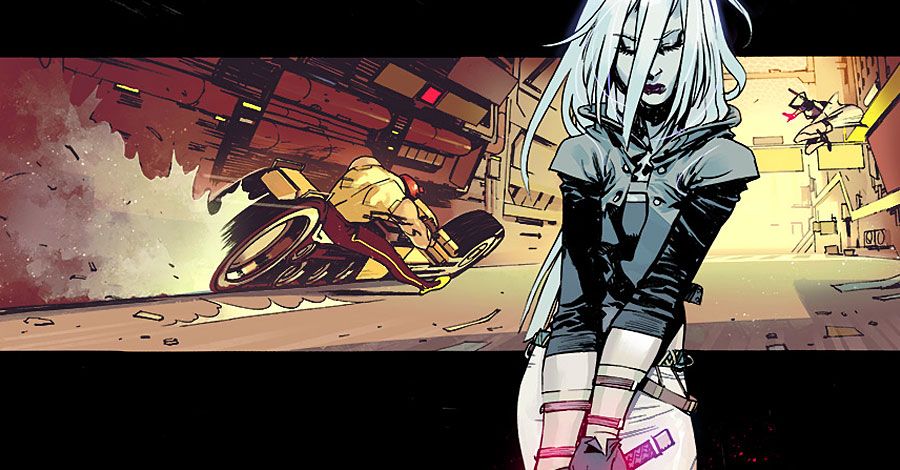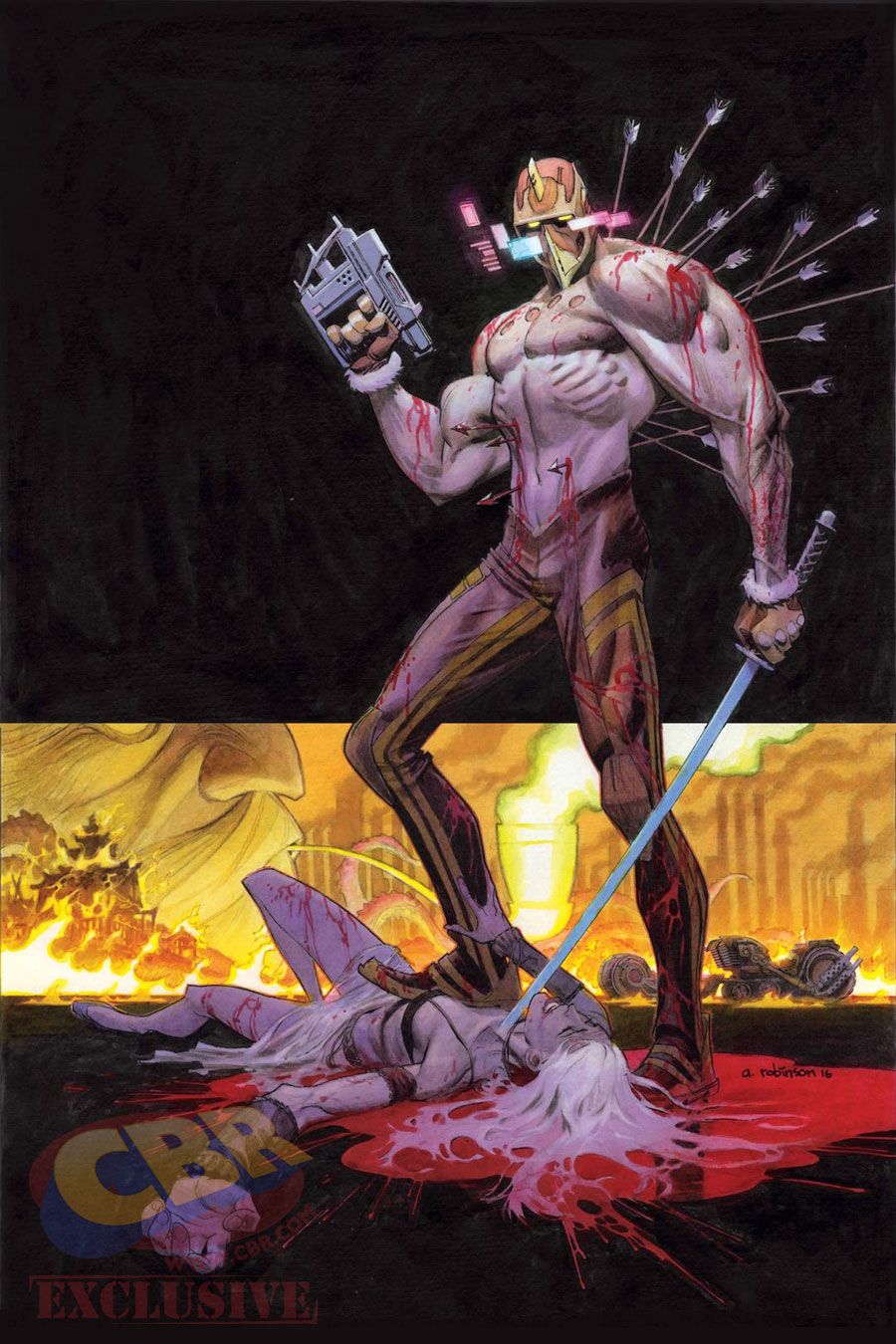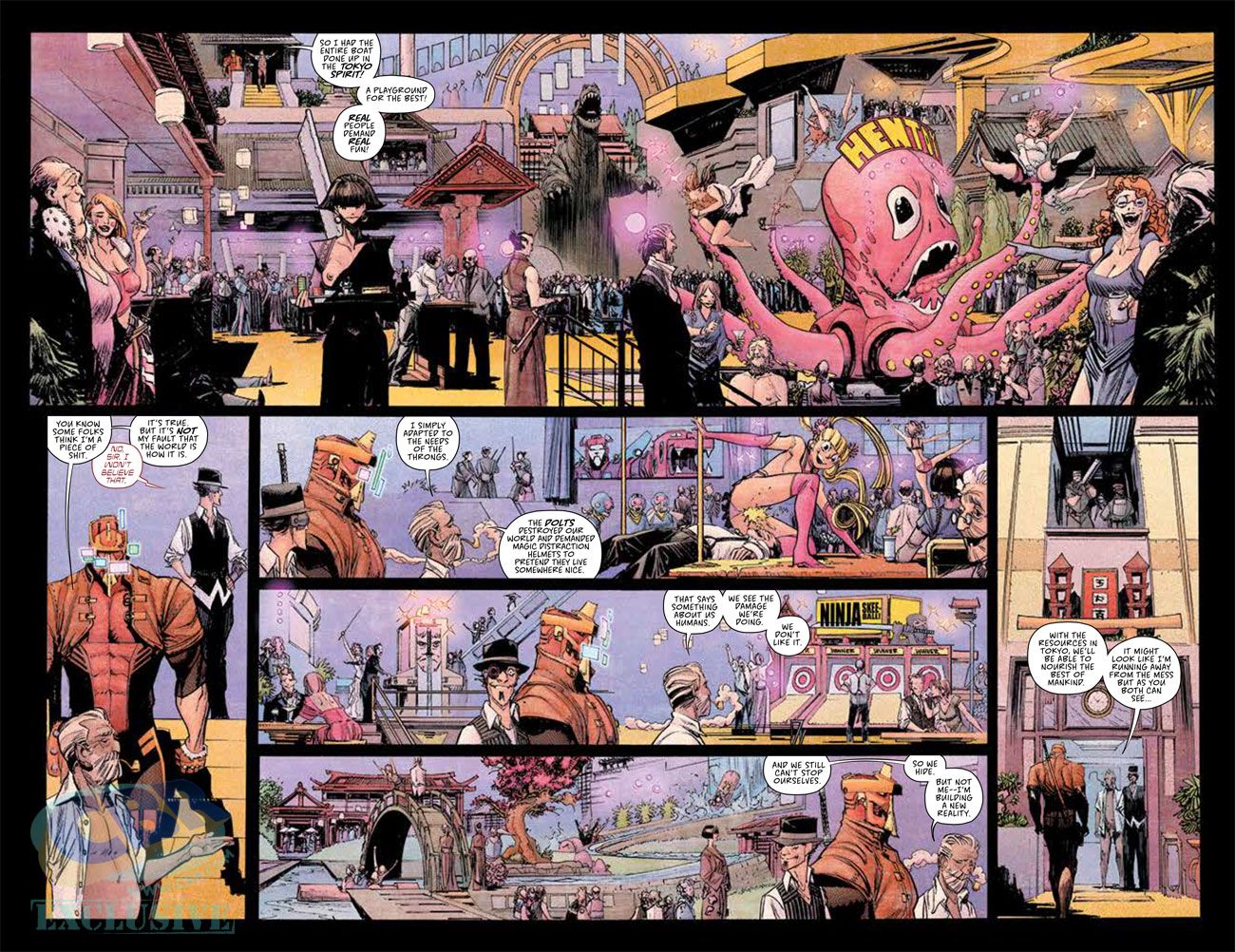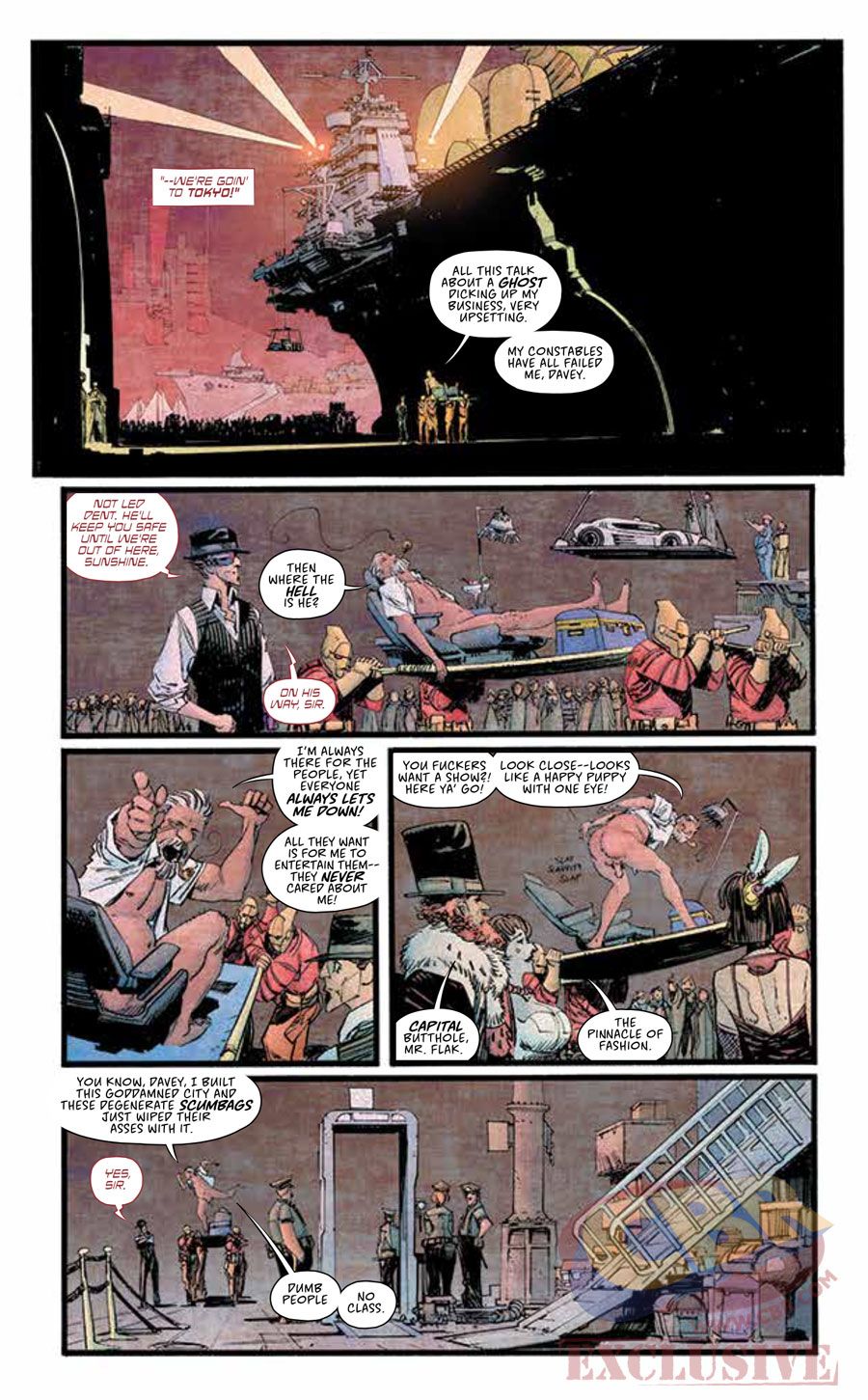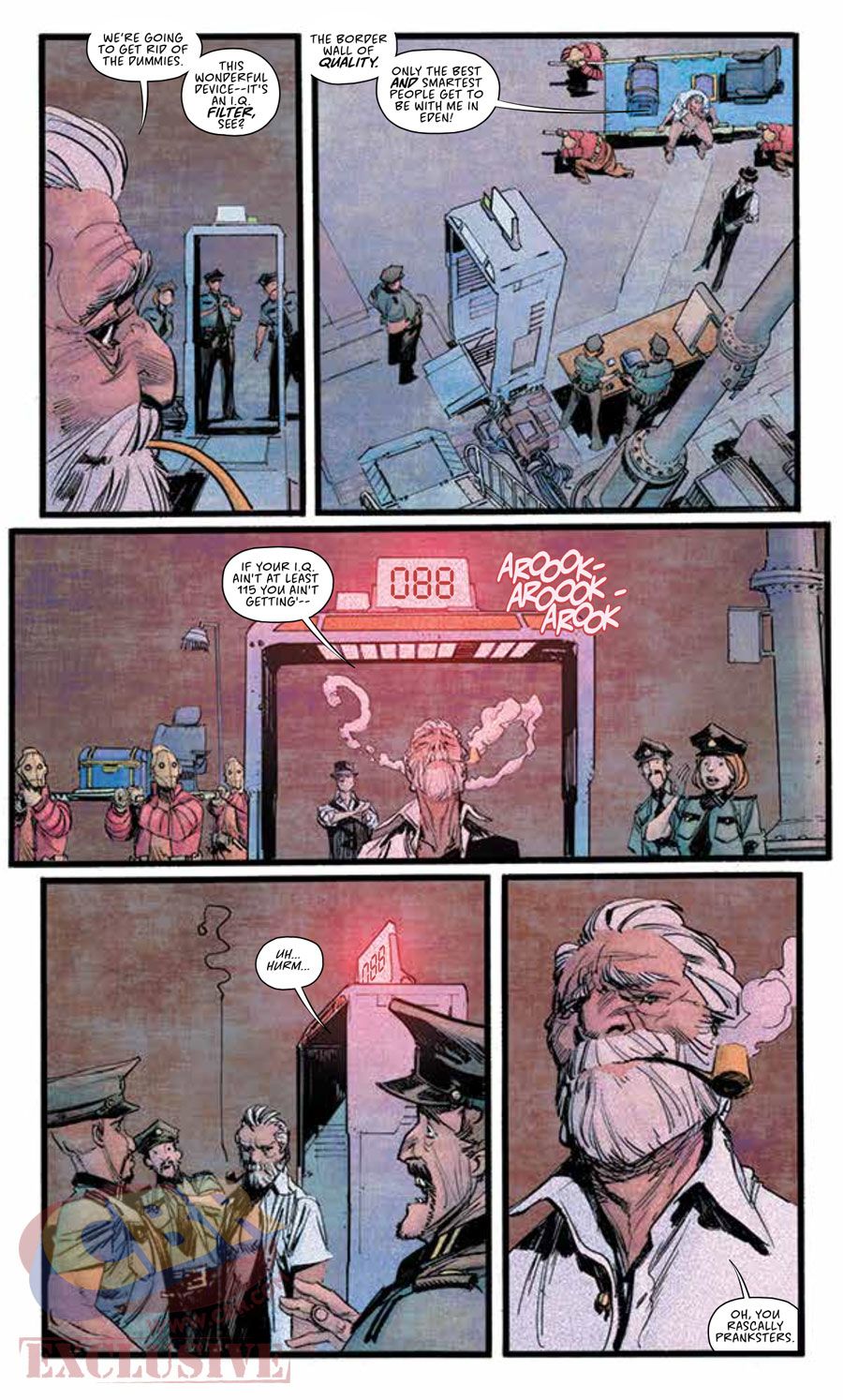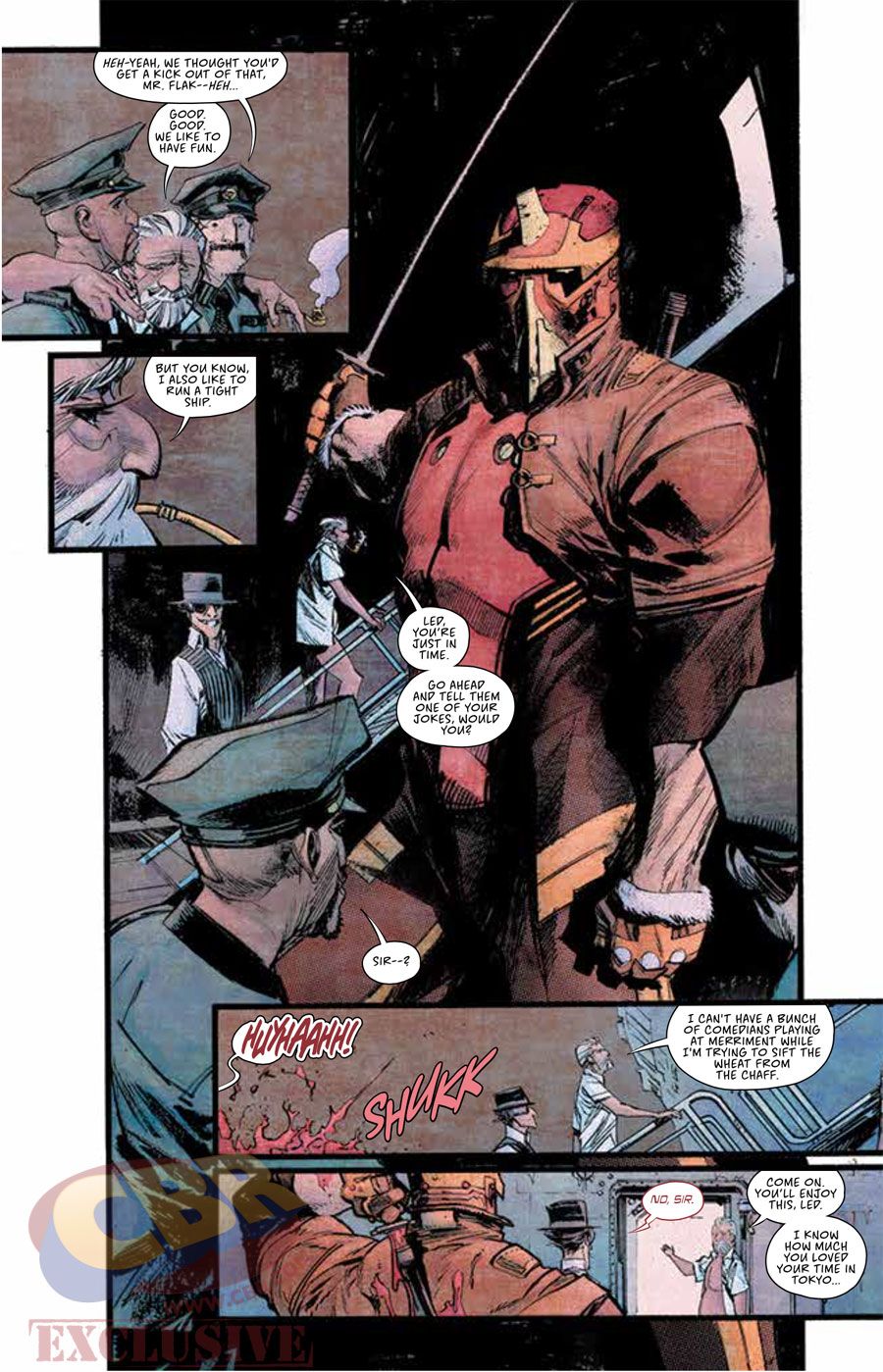In the nightmarish world of Rick Remender and Sean Murphy's "Tokyo Ghost," two of the most powerful forces in all existence are love and distraction. In the Image Comics' series' first arc, those forces collided in Debbie Decay and her lover Led Dent. The pair serve as Constables, enforcing the rule of the greedy, corrupt Flak corporation which controls the citizens of Los Angeles with an endless supply of technology and distracting video feeds. Debbie, however, lived tech-free, dreaming of a better life for her and Led in the legendary paradise of Tokyo. Thus, when the chance came for them to travel there, they took it. For a while, the two were happy living a simple life, but tragedy struck as Led succumbed to his tech addiction, setting off a series of events that culminated with the destruction of Tokyo and the apparent death of Debbie.
In "Tokyo Ghost" #6 Remender and Murphy picked up their story one year later, with Led back on the streets of Los Angeles, hunting the strange criminals opposing Flak. But this time, someone is hunting him -- a terrorist known as the Ghost of Tokyo, who has targeted Led and Flak for destruction.
RELATED: Remender, Chaykin & More Bring Rock Music, Terrorists & Winnebagos to Image
CBR News spoke with Remender about the fallout from the series first arc and its larger themes of love, addiction and toxic masculinity. The writer revealed the inspiration for the bizarre villains Led battled in Issue #6, what goes into the creation of the series' surprise supporting characters, and Murphy's ability to fully realize fantastic environments. Remender also announces that "Tokyo Ghost" #10, which brings the creator-owned title's second arc to a close, is the series' final issue -- at least, for now.
CBR News: It's been a while since we spoke about "Tokyo Ghost," so I wanted to start by talking about something that became clear from reading the series' first arc. One of the things this book is about is loving someone with an addiction.
Rick Remender: That really was the interesting part of it to me as we were digging into this. We've seen the addicted to technology aspect before, and we definitely had some things that we wanted to say about that. The thing I really fell in love with, though, was Debbie as somebody who was in love with a man who became addicted to tech.
As with any addiction, we see codependency sort of rear its ugly head in all kinds of people. When I was in therapy a few years ago, and kind of digging into some similar stuff, I really fell in love with the idea that we would be seeing codependency to people who are addicted to technology. It's probably already happening; we're just not hyper-aware of it.
Another interesting facet of the first arc is the reveal of Led Dent's origin. In those flashbacks, you showed how a skinny, scared boy named Teddy, who was mocked for being beaten in a viral video, volunteered to be transformed into the hulking, brutish Constable. With that flashback, "Tokyo Ghost" also became a story about the damage done by toxic masculinity.
Yeah, it was fear of weakness. In terms of that character, Teddy versus Led, Led is the hyper-masculinity, the overreaction and over-compensation to the fear of being weak and being picked on. It was important that the characters have unique and relatable weaknesses and strengths, and, ultimately, be incredibly weird.
I think one of the joys of creating books [from] whole cloth is that we get to face the challenge of trying to do something that's familiar, but hopefully unique. In "Tokyo Ghost," we've got the toxic wasteland of Los Angeles versus the garden state of Tokyo. We've seen those ideas before, but I think in Sean and [colorist] Matt [Hollingsworth]'s capable hands, it's taken a unique twist. In my opinion, though, the strange and unique elements of our story really come from our characters.
Speaking of characters, one who appears to be more important to the story than I initially thought, given his role in the destruction of Tokyo at the end of the series first arc and his later appearance, is cyber-terrorist Davey Trauma. Was Davey always going to play a pivotal role in "Tokyo Ghost?"
Yeah, the idea was to set up a villain and make him seem like a one-off, where you meet him and you use that as an excuse to zip around the world, have fun, and get a look at this place. That was our first issue. We introduced the world, as well as Debbie and Led, and our main villain, Davey. You don't really know that he's the main villain until issue #5. Hopefully, when people read that, it was a nice surprise.
It's interesting seeing him work with your other villain, the head of the Flak corporation.
There's definitely some more interesting stuff coming up with those two. Every so often, certain members of the rich and powerful employ the aid of things that are evil, and oftentimes that causes quite a bit of trouble for them.
When issue #6 picked up, we were back in the Isles of Los Angeles. Is this dystopian version of L.A. part of the core story you plan to continue to explore?
Yes, the Isles of Los Angeles serves as sort of an analogy for all of us as we hide from reality online. There was something I noticed in my behavior a few years ago, where if I was faced with having to clean the house or do a task that I didn't like, I would inevitably end up on the Internet and wasting time. So often, when I looked at what's on there, I would become engrossed in pedantic nonsense, especially when I was working at Marvel, and I would end up dealing with some of the more fanatical aspects of their readership. The juxtaposition would just become very curious to me. I would read news articles about the melting of the Arctic shell and the incredible heat waves on one side of the continent while the Arctic winds are being released and dumped on the East Coat. There's flooding in Pakistan that used to be relegated to the oceans, and just a total climate shift that's happening. Yet, we are reserving our anger for things like comic book movies.
That was a very fascinating idea, because I would say if you went online, you would find more people furious about a superhero comic book or a superhero movie than you would find people actively and emotionally furious over what fracking might be doing to the environment, or actively furious at the Texas-sized mountain of garbage in our oceans and the plastic that's deteriorating and poisoning all of the sea life. Nobody has that same vitriolic anger. I think it's an infantilization of our culture, where we're now looking back to our childhoods and bathing in all of those things that made us feel comfortable and safe so we don't have to face the horrors of what's coming down the road for us because of what we're doing to the planet.
In our story, in the Isles of Los Angeles, everybody is living in the sewer. They're living in this toxic wasteland where life is meaningless, and they're basically escaping it by being jacked into 20 or 30 feeds, keeping themselves dialed into an artificial world.
Many of the feeds they're engrossed in are grotesque and dehumanizing.
Absolutely. It's an ugly place. That's obviously a huge magnification, but in terms of how I see where we're headed, it's like, once we perfect virtual reality, the escape option of the Internet will be incredibly powerful. You're going to have a larger population that are jacked into virtual reality while the world that they actually live in is crumbling around them.
Discussing feeds and distraction brings up another possible influence on your story that never even occurred to me until today -- Howard Chaykin's "American Flagg" series.
That's interesting -- I just had a really nice conversation with Howard at the Image Expo, and we talked about that stuff. Howard was a big influence on me in my formative years. I definitely loved those books, but I haven't read that stuff since the '80s. So if there are aspects of that showing up, it's definitely seeping out of the subconscious.
The final pages of Issue #6 introduced readers to the series' titular character, who looked an awful lot like Debbie Decay. What can you tell us about the Ghost of Tokyo?
Nothing! [Laughs] I can't say anything without spoiling stuff. In our story, Tokyo just happens to be a place where refugees from all over the world congregate. Because of what it's leader Kazumi was doing and her ability to broadcast an E.M.P., which turned off all technology, Tokyo sort of regrew. There was no tech. There was no industry. There was no pollution. It became the sort of idyllic Utopia, where people from all over the world could come and live happy, clean and free from tech.
It was also meant to symbolize Debbie's greatest desire, the thing she wanted most. What comes out of the destruction of Tokyo and the various elements we set up in that first story will hopefully be a surprising thing to come down the road.
While the Tokyo Ghost was emerging from the shadows, Led Dent battled a new batch of fun and weird rogues that you and Sean concocted -- Jack Horner and The Infantalized Nostalgic Nursery Justice warriors.
[Laughs] I'm an idiot!
What inspired the creation of those characters?
Every once in a while, I realize I'm sort of on the rails of a plot. I knew we had to get back to L.A., and we had to set up the new status quo after the events of our first story. I also knew we had to show that Led had resumed his career as a Constable, so as I was developing an aspect of that world, something that would also illuminate the desperation of the people of the city as well as giving us a big action set piece, I just let myself go off the reservation and go a little crazy and have some fun.
I had been cleaning out the garage and we were giving away a bunch of the books that my kids were done with from when they were younger. I saw a nursery rhyme book and it was like, "Oh -- well there you go! Ridiculousness." [Laughs]
There was also something to be said about groups of people in the city. In issue #1, we set up that people were undergoing a lot of body modifications; basically, permanent cosplay. As I mentioned, we're seeing all these adults obsessed with this stuff that they had when they were kids, so I had the idea to follow that back a little bit further and go all the way back to nursery rhymes, and make this a group of people who body-modded themselves to become the nursery rhymes.
I could literally write those types of stories for a hundred years. Issue #6 is probably my favorite so far, because of the big fun of it all. It informs about the characters and the world, but at the same time, it allows Sean to go apeshit crazy.

When you write something in a script that has someone driving a hot rod that looks like a piece of pie, you have to have a certain kind of artist to come in and deliver, and Sean did. That's the kind of thing that makes me really enjoy making comic books -- doing something that's big, crazy, fun and challenging, and then seeing what the artists come up with. It was definitely one of the most fun issues, for me, anyway.
Not only is Sean's design work fantastic, but the sheer amount of detail in his backgrounds is staggering.
Right! That scene where the giant rubber ducky zeppelin is gripping a giant pie while it's crashing into a building? Good Lord! And the joy of that, when you have somebody who takes the time to establish environments, is, by the time you've read five or six issues, Tokyo and Los Angeles feel like established places.
You've gone from the gutters of Los Angeles, to the canals, to the high rises, to downtown in the same way we went all over New Tokyo. There, we went from the shoreline into the town. Sean is someone who establishes those worlds, visually, in a way that I can't with words. I need an artist who's willing to take the time and sink into more than just big figures, who's willing to fall in love with drawing the environments, and Sean does that like few other people.
I'm very fortunate in that I work with a lot of artists who enjoy drawing environments. I don't think it's something that people necessarily take for granted, but I also don't think people appreciate just how much it adds to the world in which they're being immersed. There's nothing harder than drawing environments, especially in a book like "Tokyo Ghost," or "Low," or "Black Science," where the environments are always changing, and we're designing, developing, and creating new worlds and new things. That is one of the most fun aspects of comic books. As long as you have an artist willing to design the environments every couple issues, you can do what would cost millions of dollars to create in a film.
What can you leave us without about the remaining chapters of this arc?
I don't want to spoil anything, but I know no one will predict exactly where this goes. I'm very, vey excited about this story. Because the first major story is 10 issues, and that's what Sean was always available for, it forced me to tell a very concise story. I think that's to the benefit of the book. Zero fat.
So, is Issue #10 the final issue of "Tokyo Ghost?" Or will it just go on hiatus for a while and perhaps return at a later date?
At this point, it's fine if the book wraps there and takes a little hiatus, but we've got some plans in place in case it might go on after that. We'll see how our schedules work out, but we're in love with the world and what we've got to play with here. I know for sure if you've enjoyed the first six issues, the conclusion to the first major story we have coming up in the next five will keep you satisfied.
I wrote a story, and Issue #10 wraps up that initial "Tokyo Ghost" story, but of course as you immerse yourself in the world, have fun, write stories, and see the artist create things millions of other ideas pop up. It's just a matter of, "Do I want to go back to working on Sundays?" [Laughs] Do I like that day off? Or do I want to add another project? I've got a love for this book, though, and its characters. I basically have an idea for the next 20 issues; it's just whether or not I can find time to put that together.

